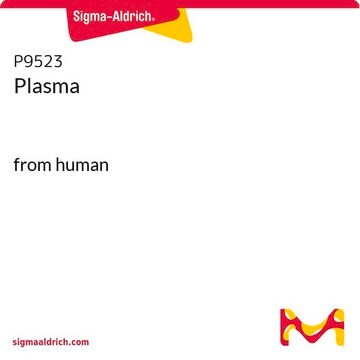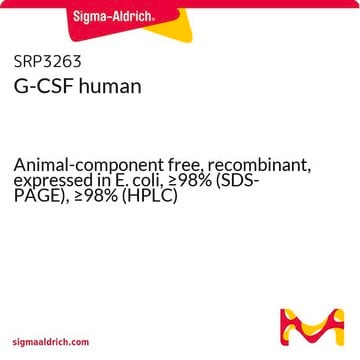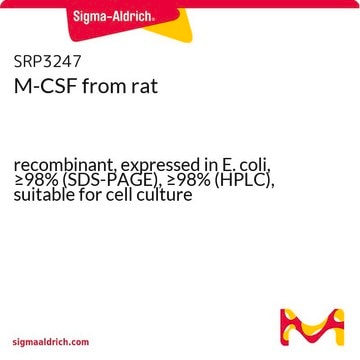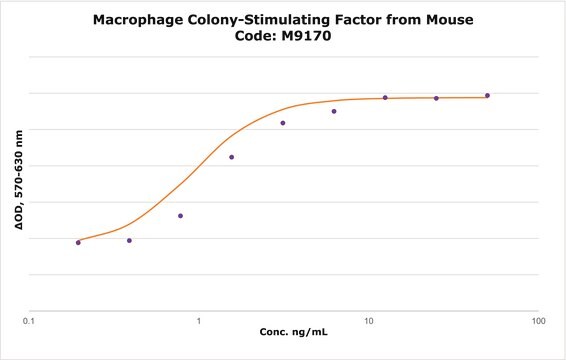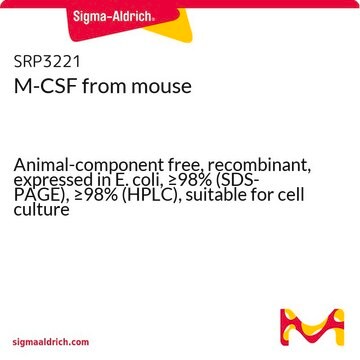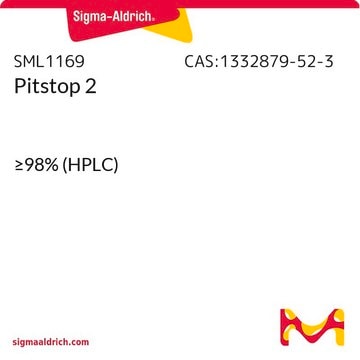SRP3332
M-CSF rat
Animal-component free, recombinant, expressed in E. coli, ≥98% (SDS-PAGE), ≥98% (HPLC)
Sinonimo/i:
CSF-1, MGI-IM
Autenticatiper visualizzare i prezzi riservati alla tua organizzazione & contrattuali
About This Item
Codice UNSPSC:
12352202
NACRES:
NA.32
Prodotti consigliati
Origine biologica
rat
Ricombinante
expressed in E. coli
Saggio
≥98% (HPLC)
≥98% (SDS-PAGE)
Forma fisica
lyophilized
Potenza
≤5.0 ng/mL ED50
PM
36.2 kDa
Confezionamento
pkg of 10 μg
Impurezze
tested
N° accesso UniProt
Condizioni di spedizione
wet ice
Temperatura di conservazione
−20°C
Informazioni sul gene
rat ... CSF1(78965)
Descrizione generale
Macrophage colony stimulating factor (M-CSF) is a potent hematopoietic factor produced by a variety of cells including lymphocytes, monocytes, fibroblasts, endothelial cells, myoblasts and osteoblasts. The gene encoding this protein is localized on rat chromosome 2q34. The human protein is reactive in murine systems, but the murine molecule exhibits no activity on human cells. Recombinant rat M-CSF is a 36.2kDa homodimeric protein containing two 155 amino acid polypeptide subunits.
Azioni biochim/fisiol
Macrophage colony stimulating factor (M-CSF) is a key regulator of cellular proliferation, differentiation, and survival of blood monocytes, tissue macrophages and their progenitor cells. M-CSF has been shown to play important roles in modulating dermal thickness, and male and female fertility. M-CSF is clinically used in the treatment of infection, malignancies and atherosclerosis. It facilitates hematopoietic recovery after bone marrow transplantation.
Stato fisico
Lyophilized from 10 mM Sodium Phosphate, pH 7.5.
Ricostituzione
Centrifuge the vial prior to opening. Reconstitute in water to a concentration of 0.1-1.0 mg/ml. Do not vortex. This solution can be stored at 2-8°C for up to 1 week. For extended storage, it is recommended to further dilute in a buffer containing a carrier protein (example 0.1% BSA) and store in working aliquots at -20°C to -80°C.
Codice della classe di stoccaggio
11 - Combustible Solids
Classe di pericolosità dell'acqua (WGK)
WGK 3
Punto d’infiammabilità (°F)
Not applicable
Punto d’infiammabilità (°C)
Not applicable
Certificati d'analisi (COA)
Cerca il Certificati d'analisi (COA) digitando il numero di lotto/batch corrispondente. I numeri di lotto o di batch sono stampati sull'etichetta dei prodotti dopo la parola ‘Lotto’ o ‘Batch’.
Possiedi già questo prodotto?
I documenti relativi ai prodotti acquistati recentemente sono disponibili nell’Archivio dei documenti.
Chemokines and the tissue-specific migration of lymphocytes.
Kunkel, E.J. and Butcher E.C.
Immunity, 1, 1-4 (2002)
Colony-stimulating factor-1 antibody reverses chemoresistance in human MCF-7 breast cancer xenografts.
Paulus P
Cancer Research, 66(8), 4349-4356 (2006)
Stanley, E.R.
The Cytokine Handbook, 387-418 (1994)
Yuying Tang et al.
Brain, behavior, and immunity, 68, 248-260 (2017-10-31)
Accumulation of microglia occurs in the dorsal horn in the rodent model of chronic post ischemic pain (CPIP), while the mechanism how microglia affects the development of persistent pain largely remains unknown. Here, using a rodent model of CPIP induced
The osteopetrotic mutation toothless (tl) is a loss-of-function frameshift mutation in the rat Csf1 gene: Evidence of a crucial role for CSF-1 in osteoclastogenesis and endochondral ossification.
Van Wesenbeeck L
Proceedings of the National Academy of Sciences of the USA, 99(22), 14303-14308 (2002)
Il team dei nostri ricercatori vanta grande esperienza in tutte le aree della ricerca quali Life Science, scienza dei materiali, sintesi chimica, cromatografia, discipline analitiche, ecc..
Contatta l'Assistenza Tecnica.